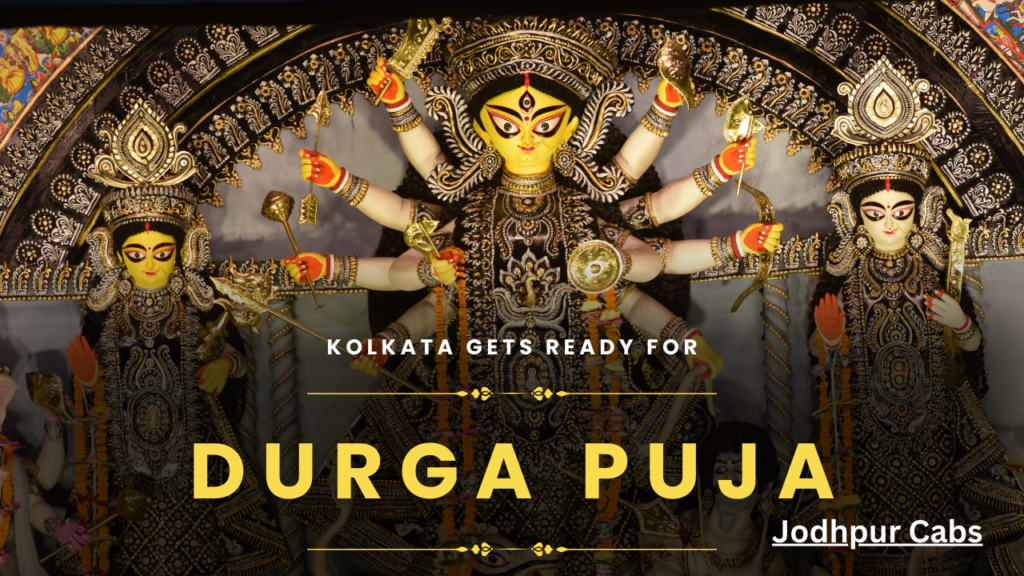Wishing Everyone a Joyous and Blessed Durga Puja!
Durga Puja Starts 2024, also known as Durgotsava, is one of the most significant and widely celebrated festivals in hire private driver in India, particularly in the state of West Bengal. The festival marks the victory of the goddess Durga over the demon king Mahishasura, symbolizing the triumph of good over evil. private driver India Tour.
Durga Puja is both a cultural and religious festival, primarily celebrated by Hindus, especially in the Indian states of West Bengal, Assam, Odisha, Tripura, and Bangladesh. It holds immense religious significance as it marks the victory of Goddess Durga over the demon Mahishasura, symbolizing the triumph of good over evil. The festival is a time of devotion, prayers, and rituals dedicated to the goddess.
Origins and Mythology
Ancient Roots: The worship of Durga can be traced back to ancient times. Durga is mentioned in ancient texts like the “Mahabharata” and the “Puranas.” The “Markandeya Purana” includes the “Devi Mahatmya,” which narrates the story of Durga’s victory over Mahishasura.
Mahishasura Mardini: According to Hindu mythology, Mahishasura, a demon king, obtained a boon from Brahma that made him invincible to gods and men. He wreaked havoc in the heavens and on Earth. The gods, unable to defeat him, combined their powers to create Durga, a powerful goddess with ten arms, each carrying a weapon. Durga battled Mahishasura for nine days and nights and finally slew him on the tenth day, known as Vijayadashami or Dussehra.
Historical Development
Medieval Period: The earliest references to Durga Puja can be found in 14th-15th century manuscripts. By the 16th century, it was celebrated as a major festival in Bengal. The landlords and kings of Bengal, known as zamindars, began organizing grand Durga Puja celebrations.
British Colonial Period: During the British rule in the 18th and 19th centuries, Durga Puja became a symbol of cultural and religious identity among Bengalis. Wealthy Bengali families, especially in Kolkata, started hosting elaborate Pujas in their homes, known as “Bonedi Barir Pujo.” The festival also became a time for social gatherings, music, dance, and cultural performances.
Public Celebrations: The tradition of community or “Barowari” Puja, where the festival is organized collectively by neighborhoods and communities, began in the early 20th century. The first such public Puja was organized in Kolkata in 1790 by 12 friends (baro means twelve in Bengali).
Modern Era
Contemporary Celebrations: Today, Durga Puja is celebrated with immense grandeur and enthusiasm. The festival usually lasts for five days, from Shashthi (the sixth day) to Vijayadashami (the tenth day). It involves the creation of elaborate and artistic clay idols of Durga and her children (Lakshmi, Saraswati, Ganesha, and Kartikeya), which are worshipped in beautifully decorated pandals (temporary structures).
Cultural Significance: Durga Puja has transcended religious boundaries and has become a cultural extravaganza. It is a time for family reunions, cultural performances, traditional music, dance, and art. The city of Kolkata is particularly famous for its grand celebrations, attracting tourists from all over the world.
Global Spread: With the diaspora of Bengalis across the globe, Durga Puja is now celebrated in many countries, including the United States, United Kingdom, Canada, Australia, and various parts of Europe and Asia, making it a global festival.
Durga Puja not only marks the victory of the goddess over evil but also reflects the rich cultural heritage and artistic traditions of Bengal.
"Mahalaya" Preparations for Durga Puja: Cultural Traditions and Festivities
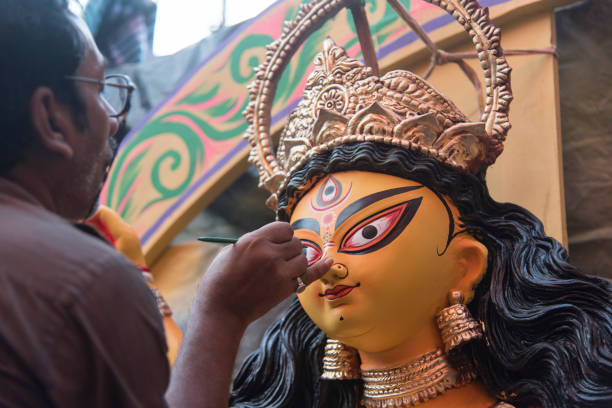
Durga Puja Starts 2024 Mahalaya is a significant event in the Hindu calendar, especially in Bengal, marking the beginning of Durga Puja festivities. hire private drive Contact No. + 91 7221822999 It takes place seven days before the start of Durga Puja, on the last day of the fortnight of the waning moon known as Pitru Paksha or Mahalaya Amavasya.
Significance of Mahalaya
Invocation of Goddess Durga: Mahalaya heralds the arrival of Durga, the divine mother. According to mythology, it is on this day that the gods and goddesses in heaven invoke the goddess Durga to descend on Earth and destroy the evil forces of Mahishasura. The chant “Jago Tumi Jago” is symbolic of this invocation. Best Hire private driver and cab in India
Pitru Paksha: Mahalaya also marks the end of Pitru Paksha, a 16-day period when Hindus pay homage to their ancestors. It is believed that on this day, the souls of the ancestors leave the Earth to go to their heavenly abode, and blessings are sought from them for peace and prosperity.
Top 10 Places Durga Puja Celebrations: A Time for Joy and Togetherness
| Kolkata, West Bengal | Highlights: Traditional and theme-based pandals, vibrant processions, cultural programs, and iconic pujas like Bagbazar, Kumartuli Park, and College Square. |
|---|---|
| Cooch Behar, West Bengal | Highlights: Royal celebrations at the Cooch Behar Palace, traditional rituals, and local cultural performances. |
| Barasat, West Bengal | Highlights: Famous for its grand and innovative pandals, artistic idol decorations, and cultural activities |
| Siliguri, West Bengal | Highlights: Mix of traditional and modern pandals, lively processions, and community events. |
| Mumbai, Maharashtra | Highlights: Celebrations by Bengali associations, notable pandals at Lokhandwala, Powai, and Shivaji Park, and cultural programs showcasing Bengali heritage. |
| Delhi | Highlights: Major pandals organized by CR Park and other Bengali communities, cultural performances, and traditional rituals. |
| Bengaluru, Karnataka | Highlights: Celebrations by the Bengali Association, vibrant pandals at Ulsoor and Koramangala, and cultural events. |
| Pune, Maharashtra | Highlights: Enthusiastic celebrations by the Bengali community, well-decorated pandals, and cultural festivities. |
| Chennai, Tamil Nadu | Highlights: Durga Puja by Bengali associations, colorful pandals, and cultural programs. |
| Telangana | Highlights: Celebrations organized by various Bengali associations, grand pandals, and cultural performances. |
Navadurga: The Nine Forms of Goddess Durga
1. Shailaputri (Daughter of the Mountain)
Form: Depicted as a beautiful woman riding a bull, with a crescent moon on her forehead and holding a trident and a lotus.
Symbolism: Represents purity and simplicity. She is the daughter of the Himalayas, symbolizing strength and stability.
Worship Day: First day of Navaratri.
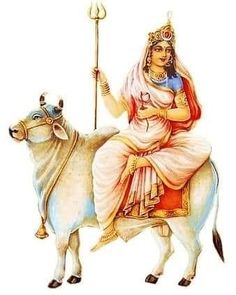
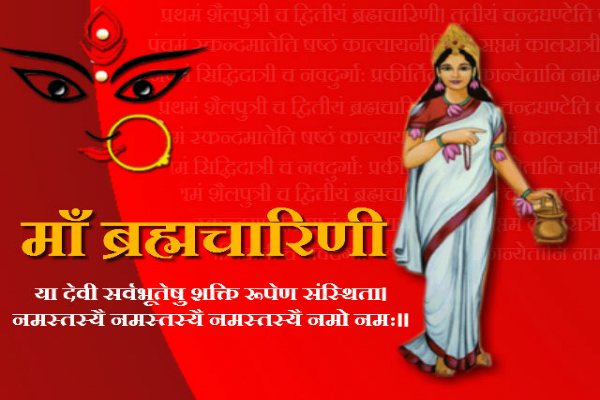
2. Brahmacharini (The Ascetic)
Form: Seen as a serene, ascetic figure with a rosary in one hand and a water pot in the other.
Symbolism: Embodies penance and self-discipline. She represents the pursuit of spiritual knowledge.
Worship Day: Second day of Navaratri.
3. Chandraghanta (The Moon-Holding)
Form: Portrayed with a bell-shaped moon on her forehead and riding a tiger. She carries various weapons.
Symbolism: Signifies courage and the ability to overcome fears. She is associated with war and peace.
Worship Day: Third day of Navaratri.


4. Kushmanda (The Creator)
Form: Depicted with a radiant smile, riding a tiger, and holding a pumpkin in her hand.
Symbolism: Represents the creative energy of the universe and the source of all life.
Worship Day: Fourth day of Navaratri.
5. Skandamata (Mother of Skanda)
Form: Shown with her son Skanda (Kartikeya) on her lap. She is depicted with four arms.
Symbolism: Symbolizes motherhood, protection, and nurturing. She represents compassion and care.
Worship Day: Fifth day of Navaratri.
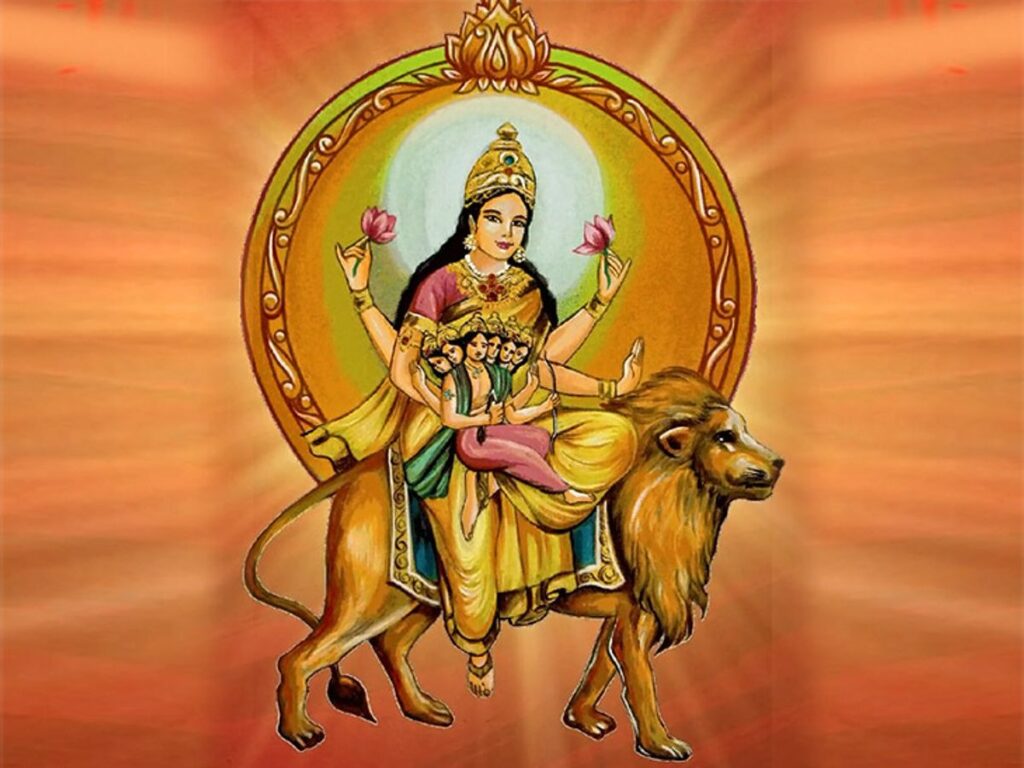

6. Katyayani (The Warrior)
Form: Depicted riding a lion, holding a sword and other weapons.
Symbolism: Represents bravery and strength. She is often associated with the slaying of demons and protection of the righteous.
Worship Day: Sixth day of Navaratri.
7. Kalaratri (The Dark Night)
Form: Shown with a dark complexion, often riding a donkey and carrying a torch.
Symbolism: Embodies the destructive aspect of the divine, associated with the removal of ignorance and darkness.
Worship Day: Seventh day of Navaratri.


8. Mahagauri (The Great Goddess)
Form: Depicted as a fair-skinned goddess, dressed in white, with a serene demeanor.
Symbolism: Represents purity, peace, and auspiciousness. She is associated with the purification of the soul.
Worship Day: Eighth day of Navaratri.
9. Siddhidatri (The Grantor of Siddhis)
Form: Shown with a serene expression and holding a lotus.
Symbolism: Represents the ultimate realization of spiritual powers and enlightenment. She is the bestower of supernatural abilities and fulfillment of wishes.
Worship Day: Ninth day of Navaratri.
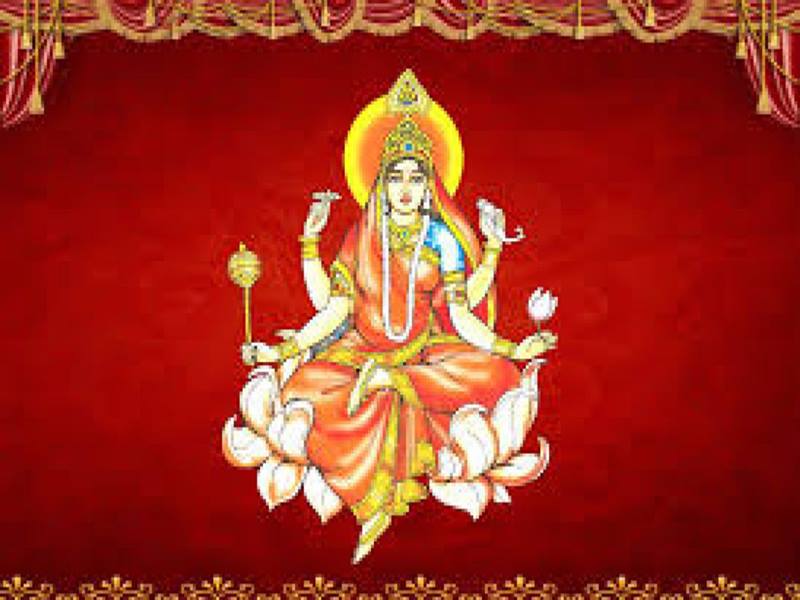
Durga Puja Celebrated 2024
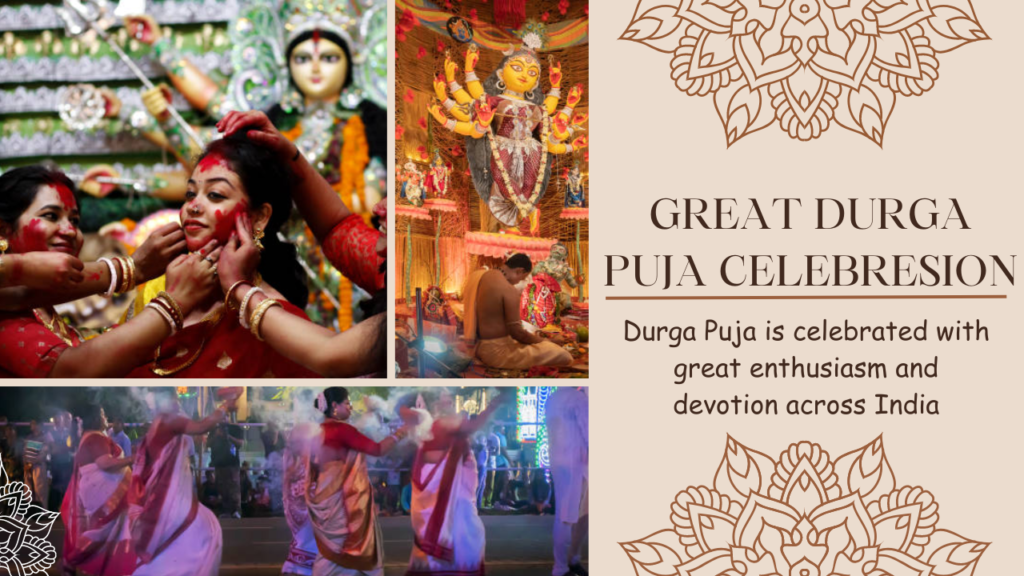
Durga Puja Starts 2024, primarily celebrated in West Bengal but also across various parts of India and the world, is a grand festival marking the victory of goddess Durga over the demon king Mahishasura. It typically spans over five days, from Shashthi to Vijayadashami, though the preparations and pre-celebrations begin well before that. Here’s an overview of how Durga Puja is celebrated, private car & driver hire in Inida car rental Agency.
Preparations and Pre-Celebrations
Idol Making:
Kumartuli in Kolkata: Artisans start crafting clay idols of Durga and her children months in advance. These idols are beautifully painted and adorned with ornaments and traditional attire.
Pandal Construction:
Temporary structures called pandals are constructed to house the idols. These pandals are often elaborately designed, some replicating famous monuments or contemporary themes.
The Five Days of Durga Puja
Shashthi (Sixth Day):
Bodhon: The ceremonial unveiling of the idol.
Kalparambha: The ritual to mark the beginning of the Puja.
Amantran and Adhivas: Inviting the goddess to accept the puja.
Saptami (Seventh Day):
Nabapatrika: A ritual involving nine different plants symbolizing the nine forms of Durga is performed.
Pran Pratistha: Invoking the goddess into the idol through mantras.
Ashtami (Eighth Day):
Sandhi Puja: A special puja performed at the juncture of Ashtami and Navami, marking the moment when Durga killed Mahishasura.
Kumari Puja: Young girls are worshipped as manifestations of the goddess.
Anjali: Devotees offer flowers and prayers to the goddess.
Navami (Ninth Day):
Maha Aarti: A grand ritual performed to conclude the day’s worship.
Bhog: Special food offerings are made to the goddess and later distributed among the devotees.
Vijayadashami (Tenth Day):
Sindoor Khela: Married women smear each other with sindoor (vermillion) and offer it to the goddess.
Visarjan: The immersion of the idols in rivers or other water bodies, symbolizing the departure of the goddess to her celestial abode.
Processions: Elaborate processions with music, dance, and chanting of “Bolo Durga Mai Ki Jai” accompany the immersion.
Cultural Aspects
Cultural Programs:
Dance and Drama: Performances depicting stories from Hindu mythology.
Music: Traditional Bengali songs, Rabindra Sangeet, and devotional music.
Competitions: Various art, dance, and music competitions.
Fairs and Food:
Food Stalls: Pandals and surrounding areas are filled with stalls selling Bengali delicacies like puchkas, kathi rolls, luchi-alur dom, and sweets like rasgulla and sandesh.
Fairs: Temporary fairs with rides, games, and stalls selling handicrafts, clothes, and other items.
Modern Celebrations
Theme-Based Pandals:
Modern pandals often follow themes ranging from historical, and environmental, to pop culture, drawing huge crowds and media attention.
Eco-Friendly Practices:
Increasing awareness has led to the adoption of eco-friendly materials for idols and decorations, reducing environmental impact.
Global Celebrations:
With the Bengali diaspora spread worldwide, Durga Puja is celebrated in countries like the USA, UK, Canada, Australia, and many others, often with a mix of traditional and local cultural elements.
Community and Togetherness
Family Gatherings: Durga Puja is a time for family reunions, visiting relatives, and spending time together.
Community Bonding: Neighborhoods come together to organize and celebrate, fostering a sense of community and shared cultural heritage.
Durga Puja is not just a religious festival but a cultural extravaganza that brings people together, transcending religious and social boundaries.
| Year | dates for Durga Puja |
|---|---|
| 2024 | Friday, October 11 to Tuesday, October 15 |
| 2025 | Wednesday, September 30 to Sunday, October 4 |
| 2026 | Monday, October 19 to Friday, October 23 |
| 2027 | Saturday, October 9 to Wednesday, October 13 |
| 2028 | Thursday, September 28 to Monday, October 2 |
| 2029 | Tuesday, October 16 to Saturday, October 20 |
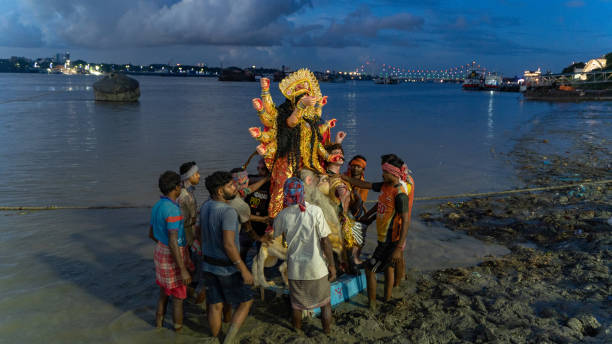
Immersion, or Visarjan, is a crucial and symbolic ritual that marks the conclusion of Durga Puja. It involves the immersion of the idol of goddess Durga into a river, lake, or other bodies of water. Here’s a detailed look at the significance, process, and customs associated with immersion:
Significance of Immersion
1.Symbolism:
Departure: Immersion symbolizes the goddess’s return to her celestial abode after spending time on Earth with her devotees. It signifies the end of the festival and the goddess’s departure until the next year.
Cycle of Life: The ritual reflects the cyclical nature of life and the continuous cycle of creation and dissolution. It represents the return of the divine to the cosmic ocean.
2. Cultural Expression:
Celebration of Unity: Immersion is often accompanied by grand processions and festivities, highlighting the sense of community and collective participation in the festival.
Artistic Closure: The final immersion marks the end of an artistic and cultural display, as the beautifully crafted idols are submerged, symbolizing their reintegration into nature.
Process of Immersion
Preparation:
1. Final Offerings: Before immersion, final offerings and rituals are performed, including the presentation of the last batch of prasad (sacred food) to the goddess.
2. Sindoor Khela: On Vijayadashami (the final day), married women traditionally apply sindoor (vermilion) on the goddess’s forehead and on each other, as part of the farewell ritual.
Procession:
1. Decorated Processions: The idols are carried in elaborate processions from the pandal (temporary structure) to the immersion site. These processions are often lively, featuring music, dance, chanting, and enthusiastic crowds.
2. Traditional Music: Devotional songs, drum beats, and traditional music accompany the procession, creating a festive and celebratory atmosphere.
3. Immersion:
Submerging the Idols: At the immersion site, the idols are carefully submerged in water. In some regions, this is done with reverence and traditional rituals, while in others, the process is more celebratory and exuberant.
Eco-Friendly Practices: To mitigate environmental impact, some regions are adopting eco-friendly practices such as using biodegradable materials for the idols and minimizing pollution.
Customs and Variations
Regional Differences:
1. West Bengal: In Kolkata and other parts of West Bengal, the immersion is a grand event, with major processions and large crowds gathering at the banks of the Hooghly River. The event can extend late into the night.
2. Other States: In states like Odisha, Assam, and Tripura, the immersion is also a significant event but may vary in scale and style. Regional customs and local practices influence how the immersion is conducted.
Need Help?
FAQs
1. What is the significance of Durga Puja?
Durga Puja celebrates Goddess Durga’s victory over the demon Mahishasura, symbolizing the triumph of good over evil.
2. Which cities are renowned for grand Durga Puja celebrations?
Kolkata is famed for its elaborate pandals and festivities. Other notable celebrations occur in states like West Bengal, Bihar, Assam, Odisha, Jharkhand, and Tripura.
3. When should I book accommodations and travel?
Given the festival’s popularity, it’s advisable to book accommodations and travel at least 2-3 months in advance to ensure availability.
4. What are the must-visit pandals in Kolkata during Durga Puja?
Some of the most celebrated pandals in Kolkata include those in north Kolkata, which are primary attractions for pandal-hopping.
5. Are there any cultural performances during the festival?
Yes, Durga Puja features traditional dance, music, and drama performances, reflecting rich cultural heritage.
6. What local delicacies should I try during Durga Puja?
Indulge in Bengali sweets like rasgulla and sandesh, as well as savory dishes such as biryani and fish preparations.
7. How can I participate respectfully in the festivities?
Dress modestly, follow local customs, and be mindful of photography restrictions in certain areas.
8. Are there any travel restrictions during Durga Puja?
Major cities may experience traffic diversions due to processions and crowded areas. It’s advisable to plan your travel accordingly and stay updated with local news.

